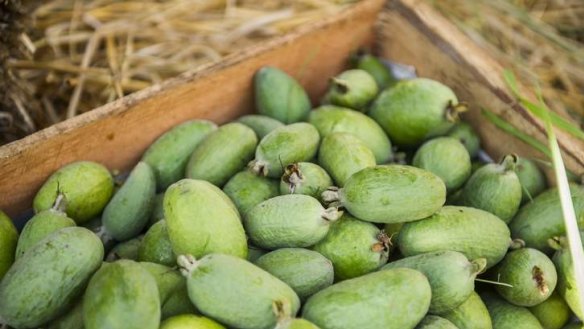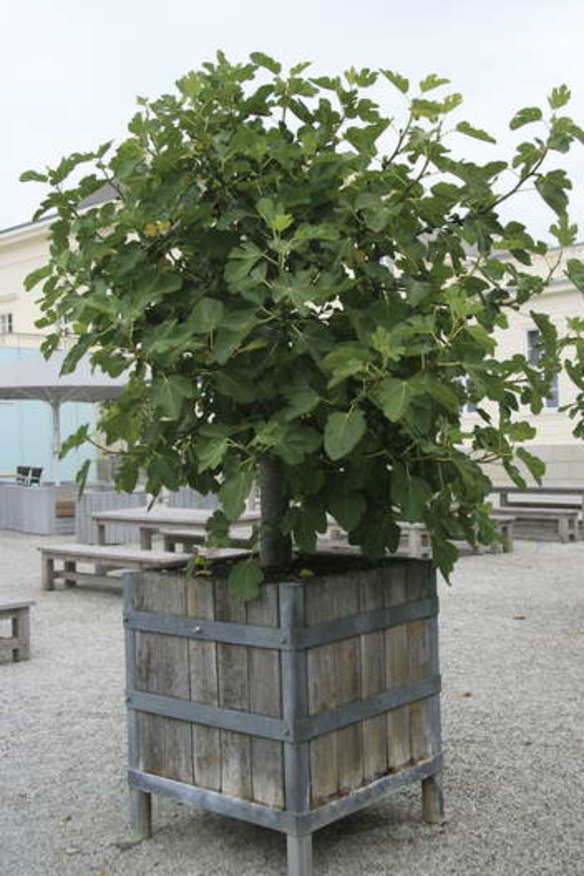Potted plants that will bear fruit

We have all seen flowers overflowing from the sides of terracotta pots along balconies, but what of fruit trees? If you grow a fruit tree in a pot, you might not see as much growth or pick quite as large a crop as from the same tree growing on a hillside, but you can still do it.
Think carefully about the size and suitability of the plant, the size of the container, the soil and the watering regime.
In the early days after new fruits arrived in Europe it was very common to grow them in large containers or wooden barrels so they could be moved indoors during winter. I've recently seen the wide variety of fruit trees growing in large containers, round and square, in the Royal Herrenhausen Gardens in Hanover, Germany. They were carrying very heavy crops of fruit.

The pot needs to be large enough to house the root ball of the tree and allow the roots more growth. Adequate drainage holes are essential. The pot also needs to provide stability for when wind is blowing across the patio. A terracotta pot or half an oak barrel will provide extra weight and stability. But there are trade-offs to consider. Terracotta is porous, so the soil will dry out more quickly than if you use plastic. And the weight of terracotta will mean less mobility.
Most trees will grow well in a loam-based compost, so use a premium potting mix and add your own finished compost. Some pieces of broken terracotta or small gravel at the base of the pot ensures good drainage.
The final size of the tree will depend in part by how much growing space the pot allows. But dwarf root stocks are now widely available and trees grafted on to such root stock naturally grow smaller overall.
Olives and citrus are ideal for growing in pots as the size can be kept within reason and they can survive winter if they're in a relatively frost-free location. Dwarf lemon and lime trees are available. Mandarins and cumquats are also very suitable for potting. All citrus needs full sun, especially during the winter fruiting months.
Figs are very suitable to pots, and can survive less watering than other fruit trees, for a time. Fig trees need firm pruning to keep their size under control. Feijoas can grow well in large pots, and you can try quinces in larger pots so long as you do rigorous winter pruning.
Many varieties of apples are now available on semi dwarfing or dwarfing root stock and these are also very suitable. Propagation Nurseries have developed the short-form central-leader Ballerina suite of apples, with full-size fruit growing on short spurs. The range includes Bolero, Charlotte, Flamenco, Maypole, Polka and Waltz. Woodbridge Fruit Trees of Tasmania and Yalca Fruit Trees of Victoria are good supply sources for apples, figs and quinces.
Trees that are vigorous and fast-growing, including the stonefruits, are not recommended because they will just produce long, new willowy branches every year.
But Flemings does supply the Trixzie registered Necatzee and the Pixzee, which grow to 1.5 metres by 1.5 metres, so you could try them in a large planter pot. Pears are not suitable, either - they will grow too tall and large.
You need a good watering regime. Plants in containers dry out far more quickly than those in the ground. You need to keep the soil moist, but not wet, at all times. Potted fruit trees should be well watered two to three times a week. When the weather is very hot or windy, they need a good soaking each day. This is vital when your trees are flowering or setting their fruit.
The roots of trees growing in pots are more susceptible to being frozen in winter as they will spread out to the very inside edge of the container and the tree does not have the natural protection of a good deep layer of soil protecting it from the frozen surface. If you need to keep the pot in situ and a heavy frost is forecast, wrap the pot with several layers of hessian or a thick potato jute bag.
Next spring, refresh the top layer of soil. Carefully remove some five centimetres of old surface soil and refill with well-matured compost.
If a tree starts to outgrow its pot, either prune the roots by removing it from the pot, teasing apart roots and trimming them, then re-pot, or you can transplant it into a larger pot.
This week:
■ Plant out lettuces, beetroot and beans in a well-prepared garden.
■ Add extra stakes and wires to support climbing beans and peas while the plants are still small.
■ Mound up the soil around your potato plants as the shoots emerge out of the soil.
■ Weed and mulch your rows of berries and complete any tying up of brambleberry vines that were missed during the winter pruning.
■ Plant a second round of tomato, capsicum and chilli seeds to provide a crop for yourself during the autumn months.
■ Keep up the thinning program of fruit trees to avoid having too many undersized fruit and to prevent branches from breaking later in the growing season. Thin down to one or two small fruits per hand span. With apples and pears, leave just one or two fruits in each cluster.
>> Owen Pidgeon owns the Loriendale Organic Orchard near Hall.
Restaurant reviews, news and the hottest openings served to your inbox.
Sign up